display HYUNDAI KONA 2022 Owners Manual
[x] Cancel search | Manufacturer: HYUNDAI, Model Year: 2022, Model line: KONA, Model: HYUNDAI KONA 2022Pages: 579, PDF Size: 35.31 MB
Page 26 of 579
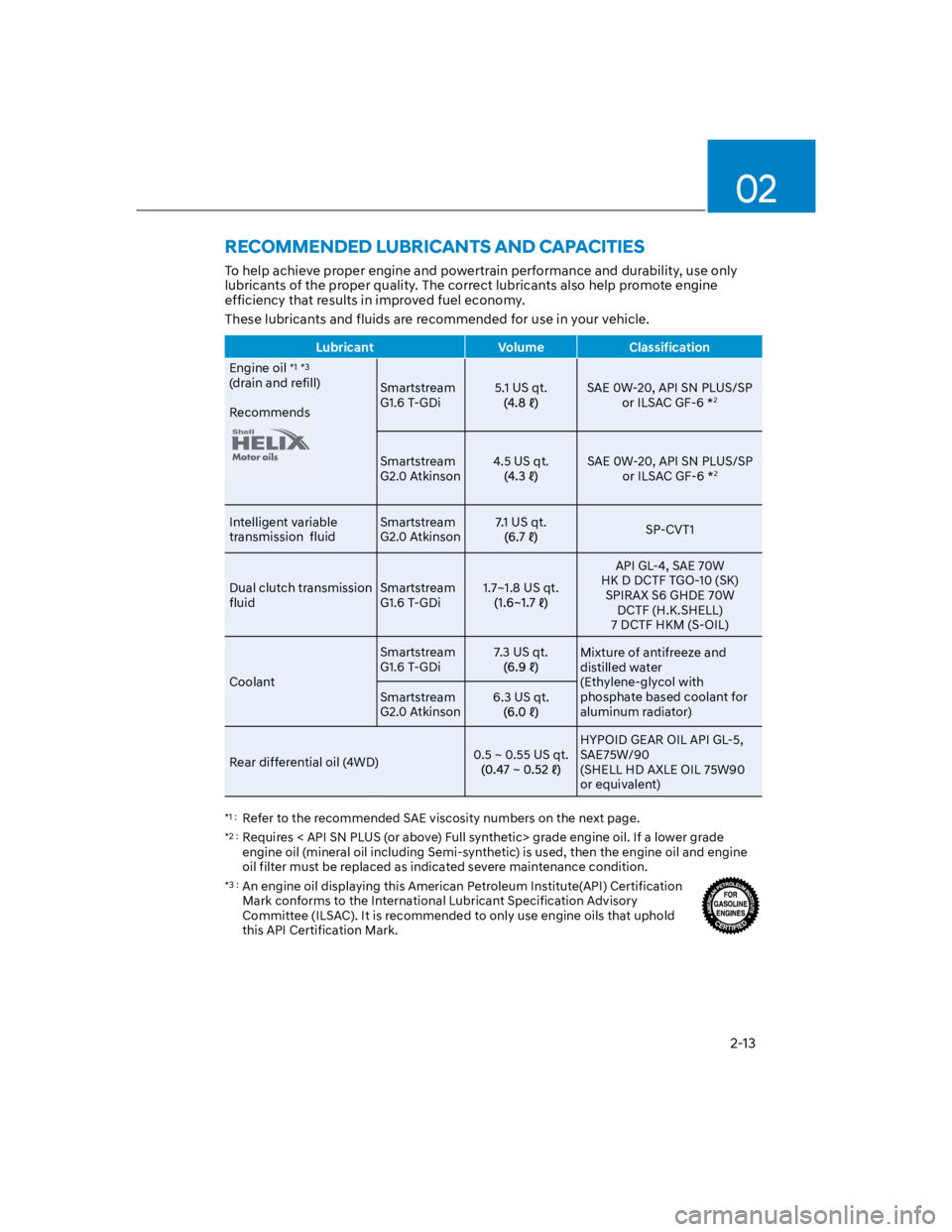
02
2-13
RECOMMENDED LUBRICANTS AND CAPACITIES
To help achieve proper engine and powertrain performance and durability, use only
lubricants of the proper quality. The correct lubricants also help promote engine
efficiency that results in improved fuel economy.
These lubricants and fluids are recommended for use in your vehicle.
Lubricant Volume Classification
Engine oil *1 *3
(drain and refill)
Recommends
Smartstream
G1.6 T-GDi
5.1 US qt. SAE 0W-20, API SN PLUS/SP
or ILSAC GF-6 *2
Smartstream
G2.0 Atkinson
4.5 US qt. SAE 0W-20, API SN PLUS/SP
or ILSAC GF-6 *2
Intelligent variable
transmission fluid
Smartstream
G2.0 Atkinson
7.1 US qt. SP-CVT1
Dual clutch transmission
fluid
Smartstream
G1.6 T-GDi
1.7~1.8 US qt.
API GL-4, SAE 70W
HK D DCTF TGO-10 (SK)
SPIRAX S6 GHDE 70W
DCTF (H.K.SHELL)
7 DCTF HKM (S-OIL)
Coolant
Smartstream
G1.6 T-GDi
7.3 US qt. Mixture of antifreeze and
distilled water
(Ethylene-glycol with
phosphate based coolant for
aluminum radiator)
Smartstream
G2.0 Atkinson
6.3 US qt.
Rear differential oil (4WD)0.5 ~ 0.55 US qt.
HYPOID GEAR OIL API GL-5,
SAE75W/90
(SHELL HD AXLE OIL 75W90
or equivalent)
*1 : Refer to the recommended SAE viscosity numbers on the next page.
*2 : Requires < API SN PLUS (or above) Full synthetic> grade engine oil. If a lower grade
engine oil (mineral oil including Semi-synthetic) is used, then the engine oil and engine
oil filter must be replaced as indicated severe maintenance condition.
*3 : An engine oil displaying this American Petroleum Institute(API) Certification
Mark conforms to the International Lubricant Specification Advisory
Committee (ILSAC). It is recommended to only use engine oils that uphold
this API Certification Mark.
Page 77 of 579
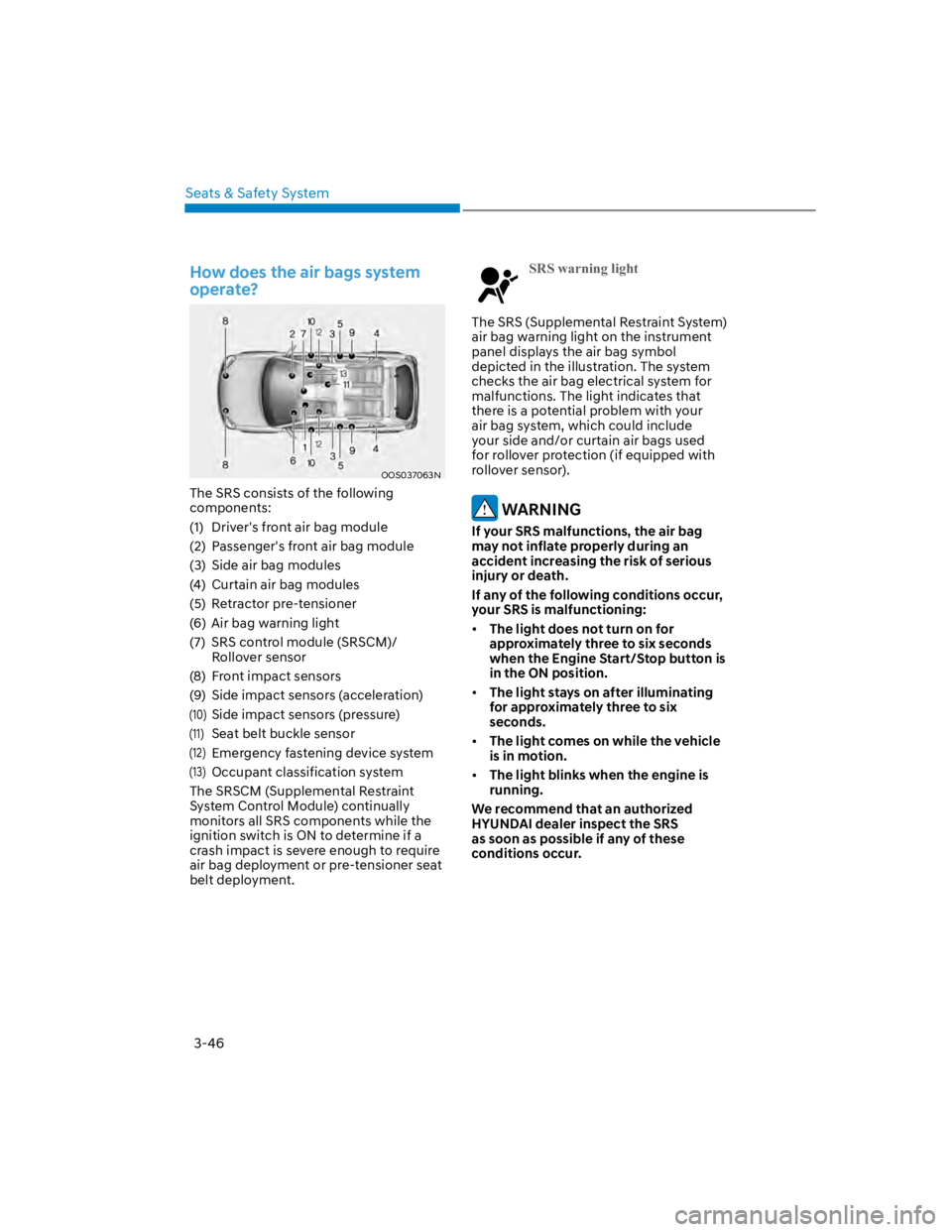
Seats & Safety System
3-46
How does the air bags system
operate?
OOS037063N
The SRS consists of the following
components:
(1) Driver's front air bag module
(2) Passenger's front air bag module
(3) Side air bag modules
(4) Curtain air bag modules
(5) Retractor pre-tensioner
(6) Air bag warning light
(7) SRS control module (SRSCM)/
Rollover sensor
(8) Front impact sensors
(9) Side impact sensors (acceleration)
(10)
Side impact sensors (pressure)
(11)
Seat belt buckle sensor
(12)
Emergency fastening device system
(13)
Occupant classification system
The SRSCM (Supplemental Restraint
System Control Module) continually
monitors all SRS components while the
ignition switch is ON to determine if a
crash impact is severe enough to require
air bag deployment or pre-tensioner seat
belt deployment.
SRS warning light
The SRS (Supplemental Restraint System)
air bag warning light on the instrument
panel displays the air bag symbol
depicted in the illustration. The system
checks the air bag electrical system for
malfunctions. The light indicates that
there is a potential problem with your
air bag system, which could include
your side and/or curtain air bags used
for rollover protection (if equipped with
rollover sensor).
WARNING
If your SRS malfunctions, the air bag
may not inflate properly during an
accident increasing the risk of serious
injury or death.
If any of the following conditions occur,
your SRS is malfunctioning:
The light does not turn on for
approximately three to six seconds
when the Engine Start/Stop button is
in the ON position.
The light stays on after illuminating
for approximately three to six
seconds.
The light comes on while the vehicle
is in motion.
The light blinks when the engine is
running.
We recommend that an authorized
HYUNDAI dealer inspect the SRS
as soon as possible if any of these
conditions occur.
Page 95 of 579

4
Turn signal indicator light ........................................................................................4-20
High beam indicator light .......................................................................................4-20
High Beam Assist indicator light ..............................................................................4-21
Cruise Indicator Light ...............................................................................................4-21
SPORT Mode Indicator Light ....................................................................................4-21
SMART Mode Indicator Light ...................................................................................4-21
Master warning light .................................................................................................4-21
LCD display messages ............................................................................................... 4-22
Shift to P (for smart key system and dual clutch transmission)............................ 4-22
Low key battery (for smart key system).................................................................. 4-22
Press START button while turning wheel (for smart key system) ......................... 4-22
Steering wheel not locked (for smart key system) ................................................ 4-22
Press brake pedal to start engine (for smart key system and dual clutch
transmission) ........................................................................................................... 4-22
Key not in vehicle (for smart key system) ............................................................... 4-22
Key not detected (for smart key system)................................................................ 4-22
Press START button again (for smart key system) ................................................ 4-22
Press START button with key (for smart key system) ........................................... 4-23
Check BRAKE SWITCH fuse (for smart key system and dual clutch
transmission) ........................................................................................................... 4-23
Shift to P or N to start engine (for smart key system and dual clutch
transmission) ........................................................................................................... 4-23
Battery discharging due to external electrical devices ......................................... 4-23
Door, Hood, Liftgate open indicator .......................................................................4-24
Sunroof open indicator ............................................................................................4-24
Low tire pressure .....................................................................................................4-24
Lights ........................................................................................................................ 4-25
Wiper ........................................................................................................................ 4-25
Heated Steering Wheel turned off .......................................................................... 4-25
Low washer fluid ...................................................................................................... 4-25
Low fuel .................................................................................................................... 4-25
Engine overheated / Engine has overheated .........................................................4-26
Check exhaust system .............................................................................................4-26
Check headlight .......................................................................................................4-26
Check turn signal .....................................................................................................4-26
Check headlamp LED ..............................................................................................4-26
Check Forward Safety system ................................................................................. 4-27
Check Lane Keeping Assist (LKA) system .............................................................. 4-27
Check Blind-Spot Safety system............................................................................. 4-27
Check Driver Attention Warning system ................................................................ 4-27
Check High Beam Assist (HBA) system .................................................................. 4-27
Check Smart Cruise Control system ....................................................................... 4-27
Page 96 of 579
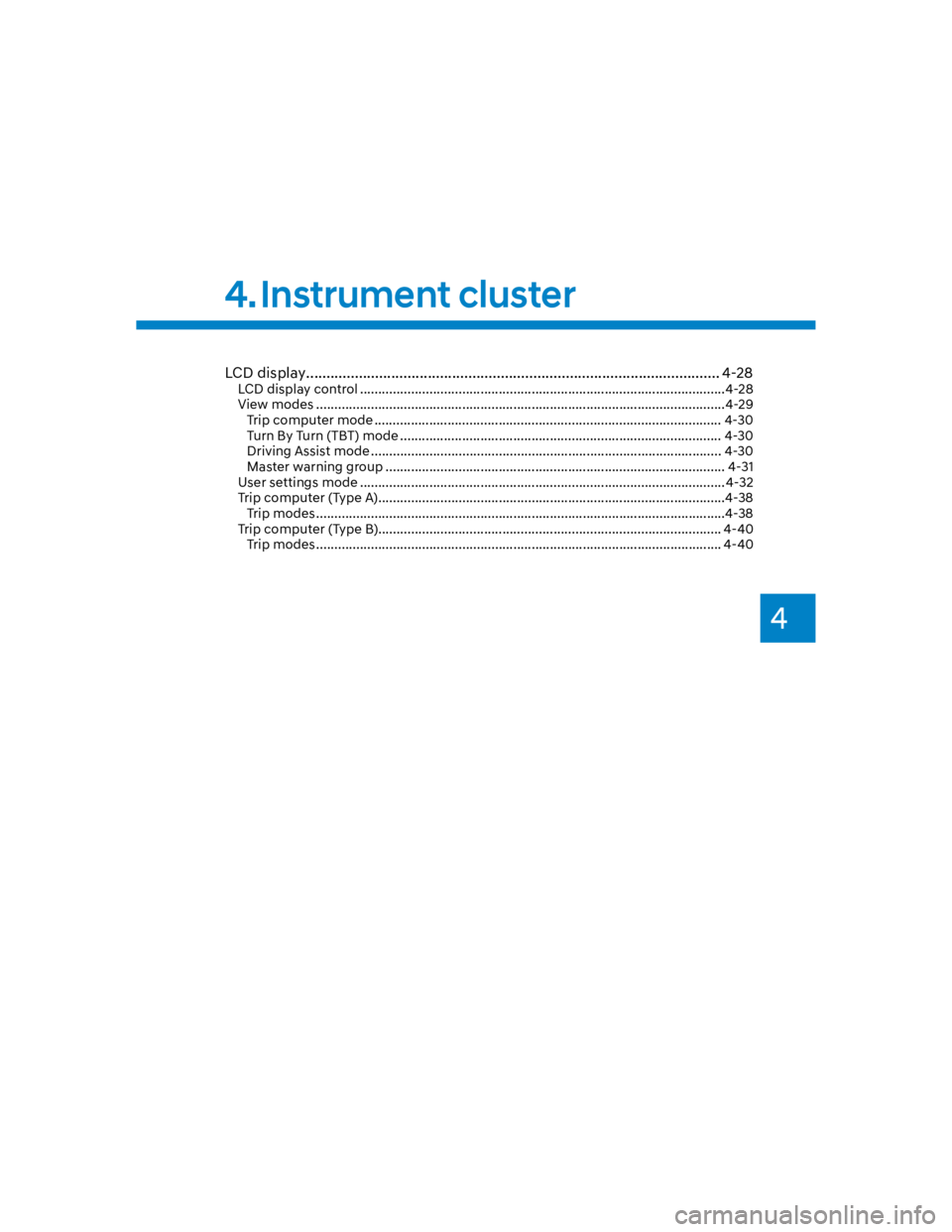
4
4. Instrument cluster
LCD display ...................................................................................................... 4-28
LCD display control ....................................................................................................4-28
View modes ................................................................................................................4-29
Trip computer mode ............................................................................................... 4-30
Turn By Turn (TBT) mode ........................................................................................ 4-30
Driving Assist mode ................................................................................................ 4-30
Master warning group ............................................................................................. 4-31
User settings mode .................................................................................................... 4-32
Trip computer (Type A)...............................................................................................4-38
Trip modes ................................................................................................................4-38
Trip computer (Type B).............................................................................................. 4-40
Trip modes ............................................................................................................... 4-40
Page 97 of 579
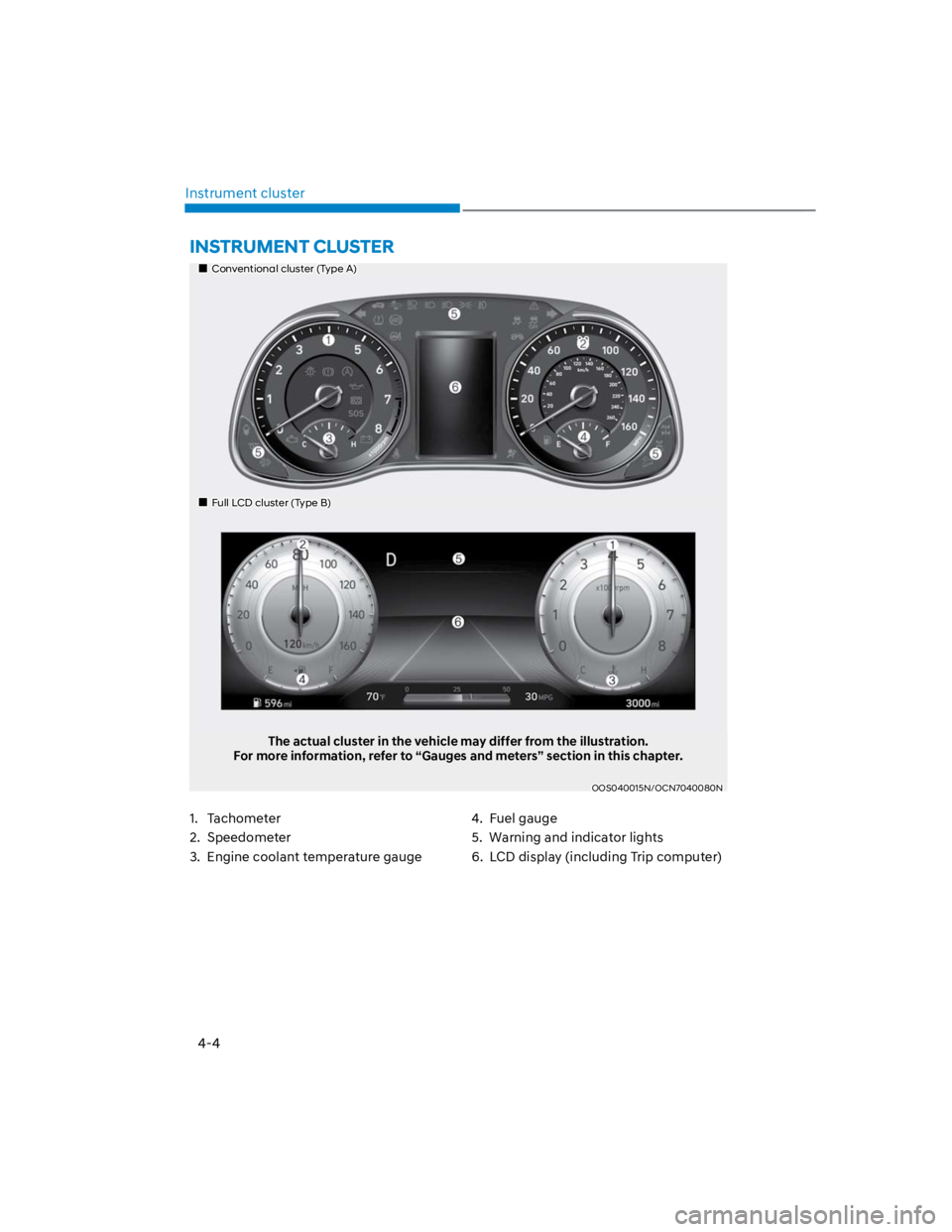
4-4
Instrument cluster
Conventional cluster (Type A)
Full LCD cluster (Type B)
The actual cluster in the vehicle may differ from the illustration.
For more information, refer to “Gauges and meters” section in this chapter.
OOS040015N/OCN7040080N
1. Tachometer
2. Speedometer
3. Engine coolant temperature gauge
4. Fuel gauge
5. Warning and indicator lights
6. LCD display (including Trip computer)
INSTRUMENT CLUSTER
Page 98 of 579
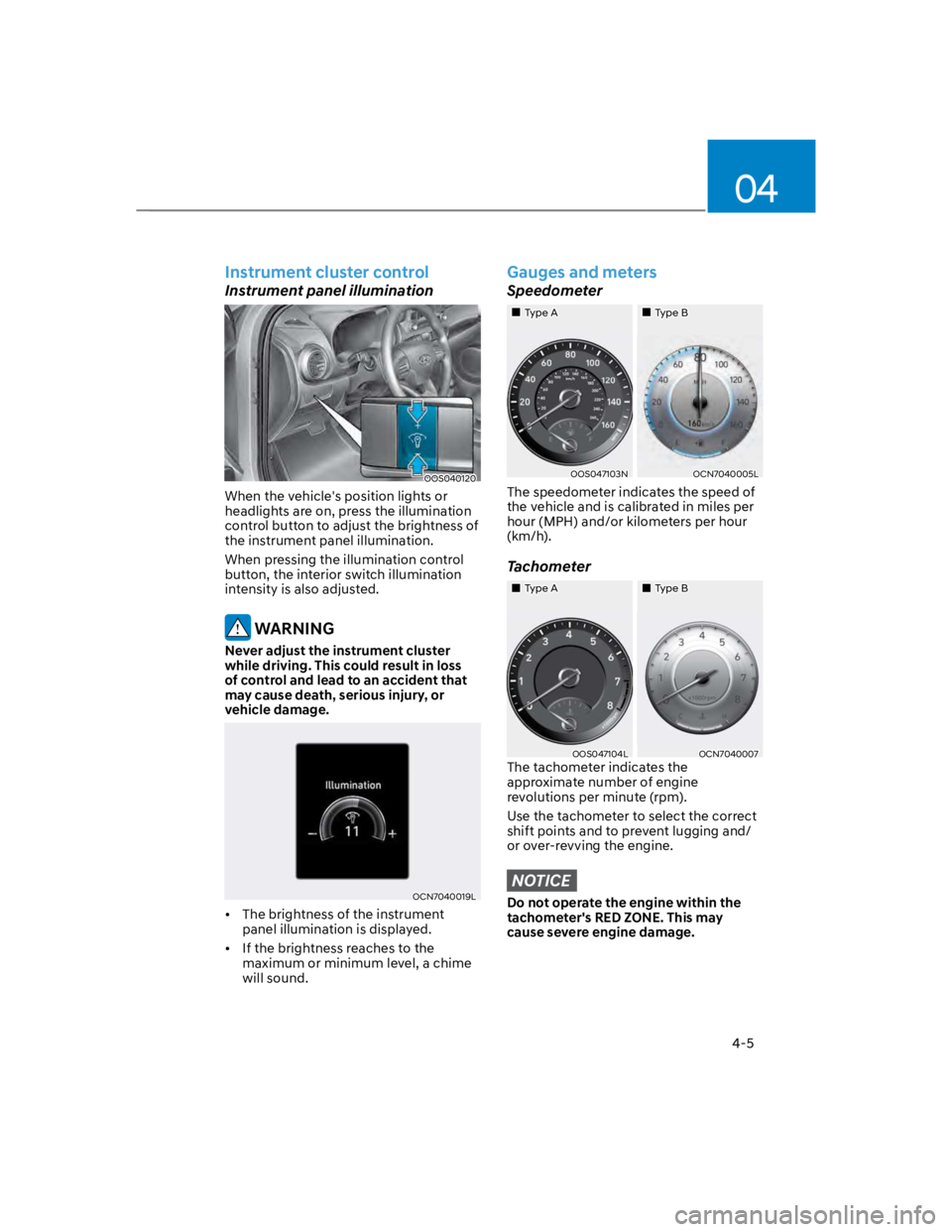
04
4-5
Instrument cluster control
Instrument panel illumination
OOS040120
When the vehicle's position lights or
headlights are on, press the illumination
control button to adjust the brightness of
the instrument panel illumination.
When pressing the illumination control
button, the interior switch illumination
intensity is also adjusted.
WARNING
Never adjust the instrument cluster
while driving. This could result in loss
of control and lead to an accident that
may cause death, serious injury, or
vehicle damage.
OCN7040019L
The brightness of the instrument
panel illumination is displayed.
If the brightness reaches to the
maximum or minimum level, a chime
will sound.
Gauges and meters
Speedometer
Type AType B
OOS047103NOCN7040005L
The speedometer indicates the speed of
the vehicle and is calibrated in miles per
hour (MPH) and/or kilometers per hour
(km/h).
Tachometer
Type AType B
OOS047104LOCN7040007
The tachometer indicates the
approximate number of engine
revolutions per minute (rpm).
Use the tachometer to select the correct
shift points and to prevent lugging and/
or over-revving the engine.
NOTICE
Do not operate the engine within the
tachometer's RED ZONE. This may
cause severe engine damage.
Page 100 of 579
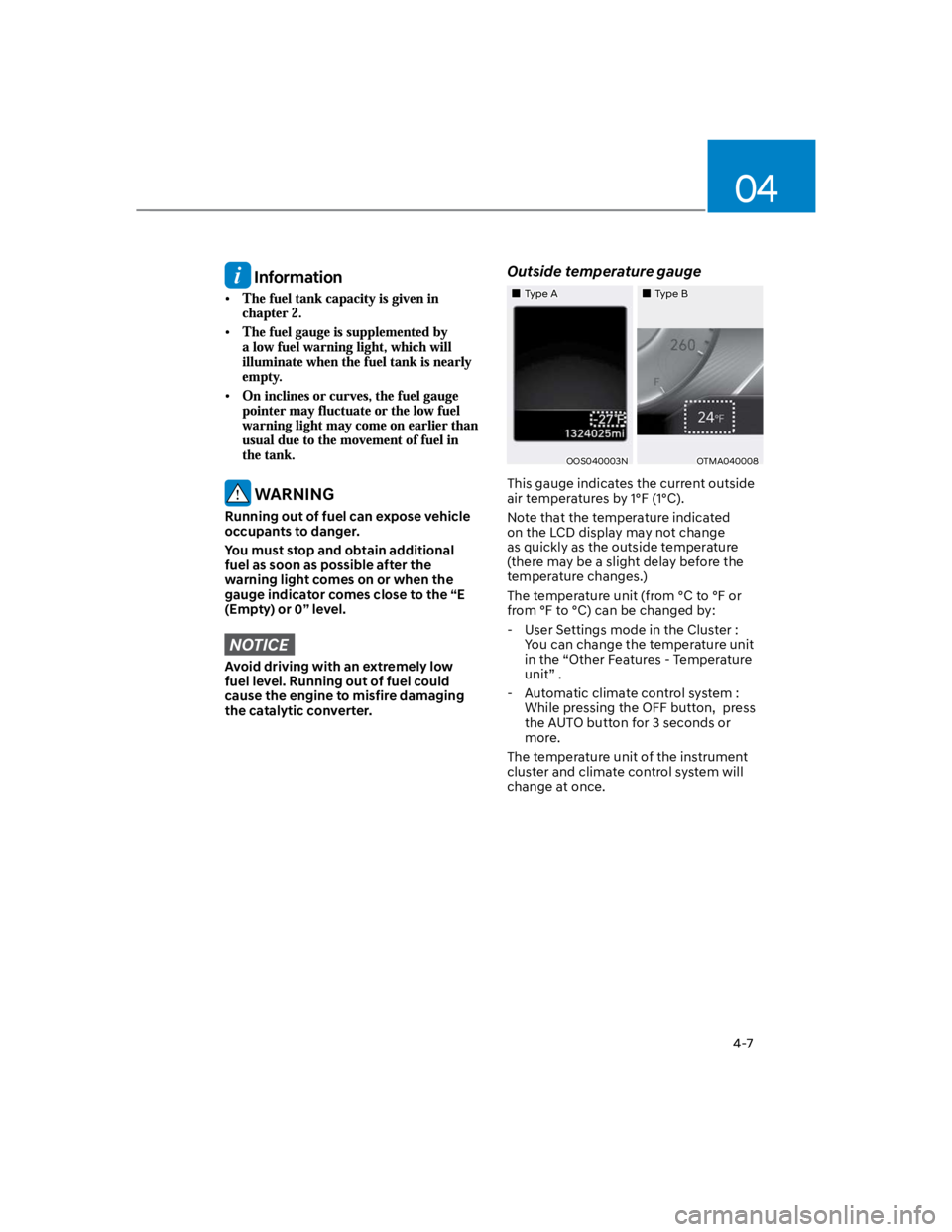
04
4-7
Information
WARNING
Running out of fuel can expose vehicle
occupants to danger.
You must stop and obtain additional
fuel as soon as possible after the
warning light comes on or when the
gauge indicator comes close to the “E
(Empty) or 0” level.
NOTICE
Avoid driving with an extremely low
fuel level. Running out of fuel could
cause the engine to misfire damaging
the catalytic converter.
Outside temperature gauge
Type AType B
OOS040003NOTMA040008
This gauge indicates the current outside
air temperatures by 1°F (1°C).
Note that the temperature indicated
on the LCD display may not change
as quickly as the outside temperature
(there may be a slight delay before the
temperature changes.)
The temperature unit (from °C to °F or
from °F to °C) can be changed by:
- User Settings mode in the Cluster :
You can change the temperature unit
in the “Other Features - Temperature
unit” .
- Automatic climate control system :
While pressing the OFF button, press
the AUTO button for 3 seconds or
more.
The temperature unit of the instrument
cluster and climate control system will
change at once.
Page 101 of 579
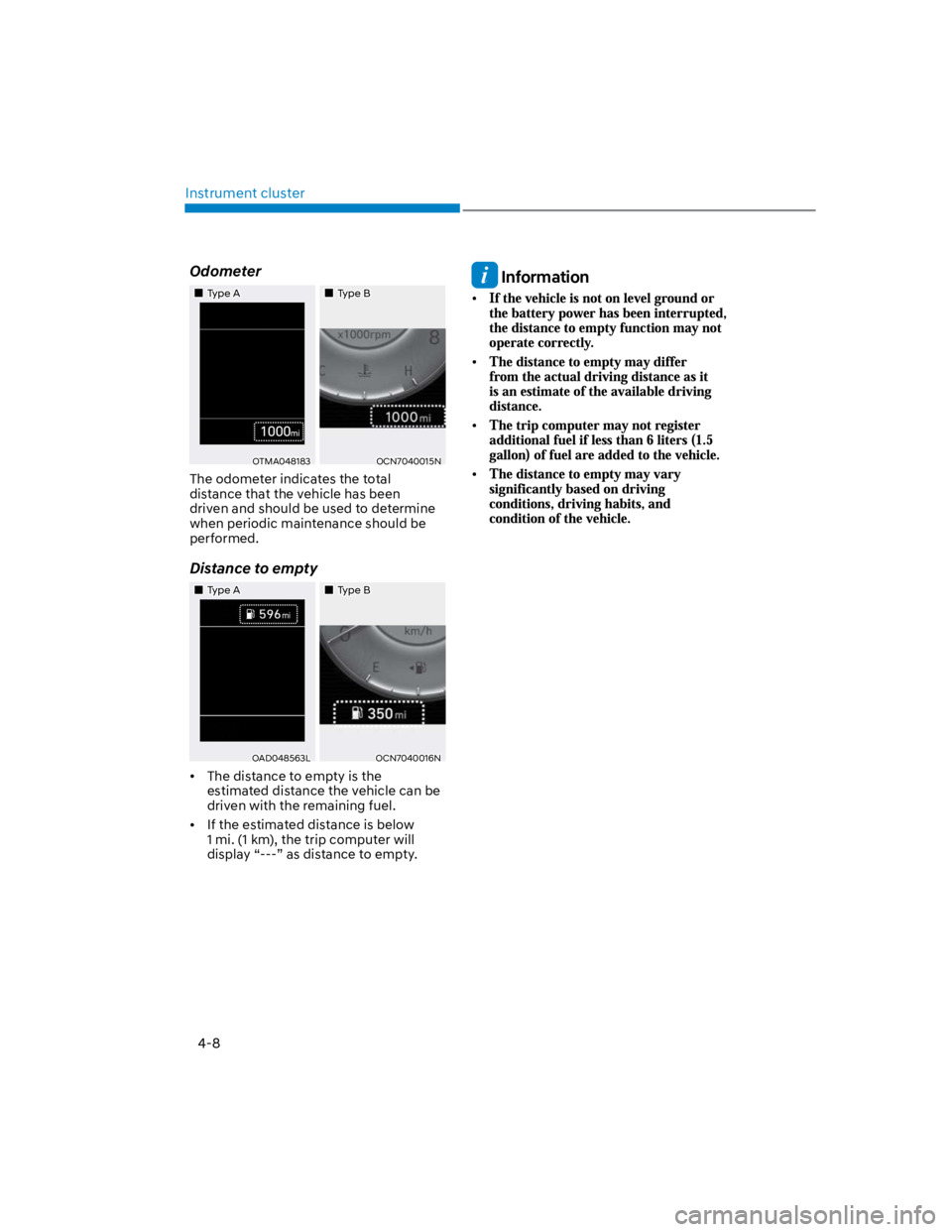
Instrument cluster
4-8
Odometer
Type AType B
OTMA048183OCN7040015N
The odometer indicates the total
distance that the vehicle has been
driven and should be used to determine
when periodic maintenance should be
performed.
Distance to empty
Type AType B
OAD048563LOCN7040016N
The distance to empty is the
estimated distance the vehicle can be
driven with the remaining fuel.
If the estimated distance is below
1 mi. (1 km), the trip computer will
display “---” as distance to empty.
Information
Page 102 of 579
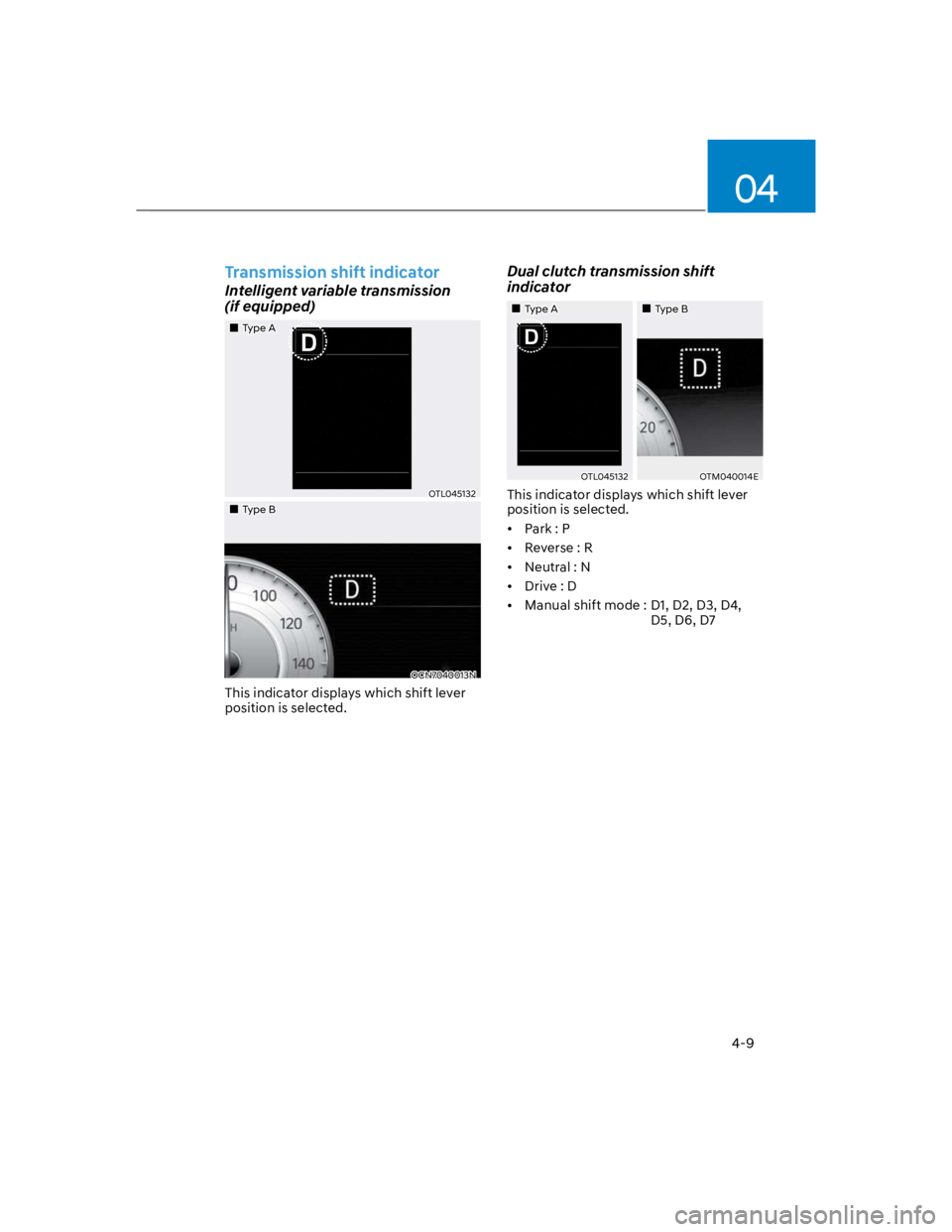
04
4-9
Transmission shift indicator
Intelligent variable transmission
(if equipped)
Type A
OTL045132
Type B
OCN7040013N
This indicator displays which shift lever
position is selected.
Dual clutch transmission shift
indicator
Type A Type B
OTL045132OTM040014E
This indicator displays which shift lever
position is selected.
Park : P
Reverse : R
Neutral : N
Drive : D
Manual shift mode : D1, D2, D3, D4,
D5, D6, D7
Page 107 of 579
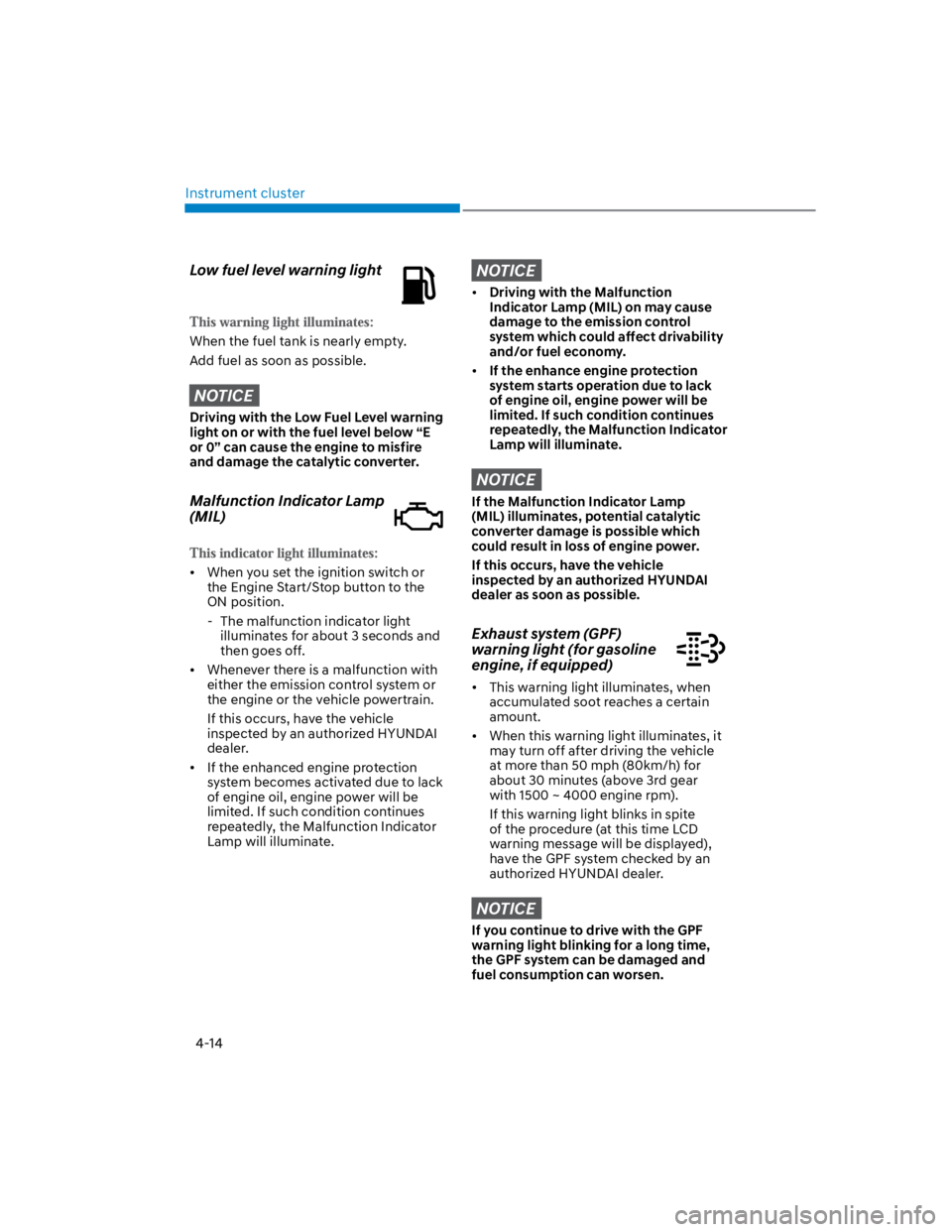
Instrument cluster
4-14
Low fuel level warning light
When the fuel tank is nearly empty.
Add fuel as soon as possible.
NOTICE
Driving with the Low Fuel Level warning
light on or with the fuel level below “E
or 0” can cause the engine to misfire
and damage the catalytic converter.
Malfunction Indicator Lamp
(MIL)
When you set the ignition switch or
the Engine Start/Stop button to the
ON position.
- The malfunction indicator light
illuminates for about 3 seconds and
then goes off.
Whenever there is a malfunction with
either the emission control system or
the engine or the vehicle powertrain.
If this occurs, have the vehicle
inspected by an authorized HYUNDAI
dealer.
If the enhanced engine protection
system becomes activated due to lack
of engine oil, engine power will be
limited. If such condition continues
repeatedly, the Malfunction Indicator
Lamp will illuminate.
NOTICE
Driving with the Malfunction
Indicator Lamp (MIL) on may cause
damage to the emission control
system which could affect drivability
and/or fuel economy.
If the enhance engine protection
system starts operation due to lack
of engine oil, engine power will be
limited. If such condition continues
repeatedly, the Malfunction Indicator
Lamp will illuminate.
NOTICE
If the Malfunction Indicator Lamp
(MIL) illuminates, potential catalytic
converter damage is possible which
could result in loss of engine power.
If this occurs, have the vehicle
inspected by an authorized HYUNDAI
dealer as soon as possible.
Exhaust system (GPF)
warning light (for gasoline
engine, if equipped)
This warning light illuminates, when
accumulated soot reaches a certain
amount.
When this warning light illuminates, it
may turn off after driving the vehicle
at more than 50 mph (80km/h) for
about 30 minutes (above 3rd gear
with 1500 ~ 4000 engine rpm).
If this warning light blinks in spite
of the procedure (at this time LCD
warning message will be displayed),
have the GPF system checked by an
authorized HYUNDAI dealer.
NOTICE
If you continue to drive with the GPF
warning light blinking for a long time,
the GPF system can be damaged and
fuel consumption can worsen.